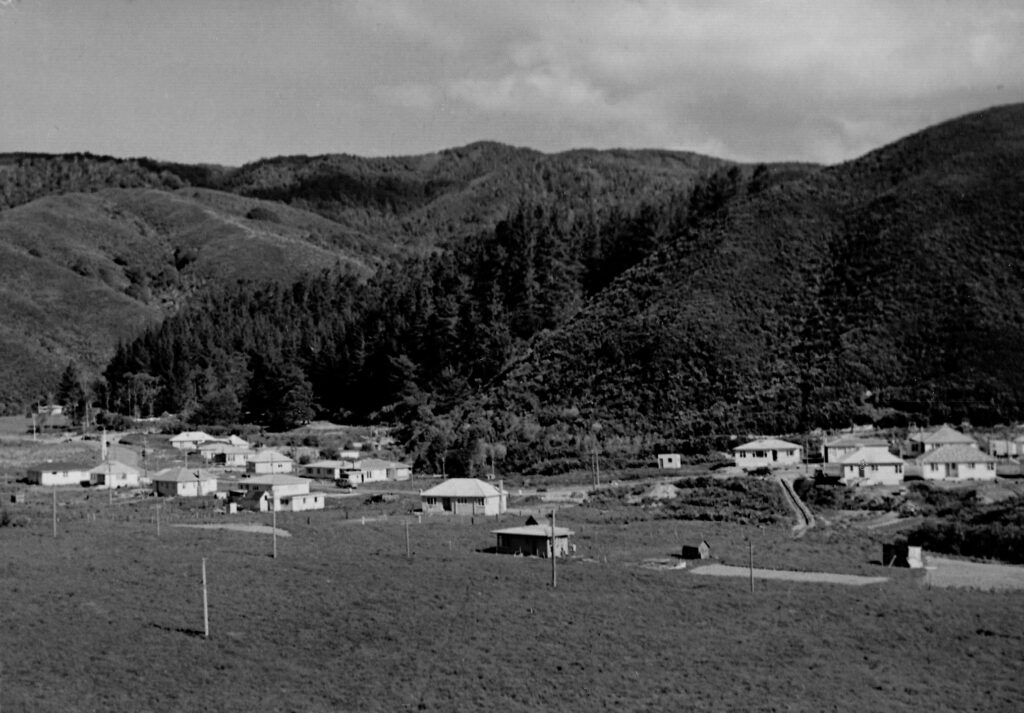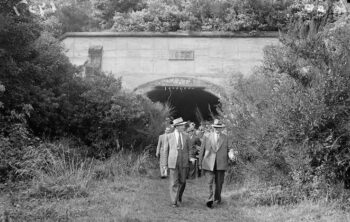Wainuiomata’s housing grew post-World War II, offering affordable homes for an expanding population.
During the 1920s, Wainuiomata began to experience significant growth. In 1928, Wainui-o-Mata Development Limited was formed with the goal of developing the valley. The company acquired 1,600 hectares (4,000 acres) of land, which were subdivided into residential lots for sale. A key part of this development was the construction of the Wainuiomata Tunnel, designed to improve access between the Hutt Valley and Wainuiomata Valley. Although construction of the tunnel started in 1932, progress was halted by the Great Depression, leading to financial losses for many investors.
After World War II, Wainuiomata saw substantial growth as affordable housing projects attracted many young couples. This influx transformed the area into a predominantly working-class community, earning it the nickname “Nappy Valley” in the 1950s due to the large number of young families. Today, many of the original houses are being demolished to make way for modern units, which fit well on the spacious quarter-acre sections common in the area.
History of housing
Wainuiomata, particularly Homedale, began as a rural farming area in the 19th century. The area was relatively isolated, with access limited by the rugged geography that surrounded it. Early settlers in the late 1800s engaged mainly in farming and forestry. The population remained small, and housing was minimal, consisting primarily of simple farmhouses and workers’ cottages scattered across large plots of land.
The most significant transformation of Wainuiomata began after World War II. Like many countries, New Zealand experienced a housing shortage after the war, driven by returning servicemen and population growth. Wainuiomata became part of a nationwide effort to build new homes in suburban areas to accommodate this demand.
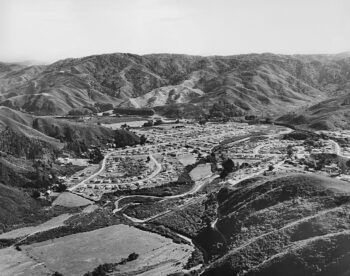 One of the first areas in Wainuiomata to undergo major residential development was Homedale. It played a key role in Wainuiomata’s post-war suburban expansion. Starting in the 1950s, Homedale was designed as a family-friendly suburb, and the homes built during this period reflected the architectural trends of the time. Houses were generally single-storey, standalone dwellings on quarter-acre sections, a hallmark of mid-century New Zealand suburban planning. These homes were often state-sponsored or built through government housing schemes, which aimed to provide affordable housing for growing families.
One of the first areas in Wainuiomata to undergo major residential development was Homedale. It played a key role in Wainuiomata’s post-war suburban expansion. Starting in the 1950s, Homedale was designed as a family-friendly suburb, and the homes built during this period reflected the architectural trends of the time. Houses were generally single-storey, standalone dwellings on quarter-acre sections, a hallmark of mid-century New Zealand suburban planning. These homes were often state-sponsored or built through government housing schemes, which aimed to provide affordable housing for growing families.
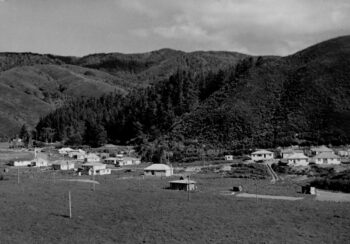 The homes in Homedale during this period were typically constructed of timber, with weatherboard cladding, gable roofs, and large front and back gardens. They were practical, modest homes designed for young families, often featuring two or three bedrooms. Many of these original homes remain today, though many have been renovated or modernised over time.
The homes in Homedale during this period were typically constructed of timber, with weatherboard cladding, gable roofs, and large front and back gardens. They were practical, modest homes designed for young families, often featuring two or three bedrooms. Many of these original homes remain today, though many have been renovated or modernised over time.
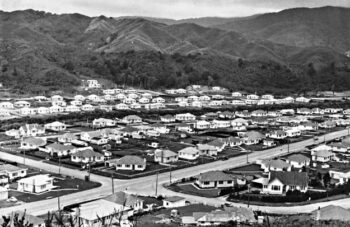 As time passed, new residential areas were developed beyond the original Homedale area. The population increased as more people moved in, seeking affordable housing and a suburban lifestyle. Homedale, being one of the earliest established areas, became a well-settled community, with a local school, shops, and parks, providing amenities for residents.
As time passed, new residential areas were developed beyond the original Homedale area. The population increased as more people moved in, seeking affordable housing and a suburban lifestyle. Homedale, being one of the earliest established areas, became a well-settled community, with a local school, shops, and parks, providing amenities for residents.
In the 1970s and 80s, the housing stock diversified. While the classic mid-century homes remained, newer builds began to appear. These homes were often larger and featured more modern amenities, reflecting the increasing expectations of suburban living. While the area experienced some economic challenges in the late 20th century, more recently, it has seen revitalisation, driven in part by the unaffordability of Wellington and other nearby urban centres.
Today
House prices in Wainuiomata are typically lower than central Wellington or other parts of Lower Hutt, making it attractive to those seeking more space or a better value home for their money. Housing consists primarily of standalone houses, often on larger sections of land. These homes are mostly single-family homes with some newer developments mixed in.
 In recent years, Wainuiomata has seen more housing development as the demand for property has grown, particularly as Wellington’s housing market continues to tighten. New subdivisions and residential projects are emerging, offering modern, newly-built homes that appeal to families and professionals looking for contemporary living options at a more affordable price point.
In recent years, Wainuiomata has seen more housing development as the demand for property has grown, particularly as Wellington’s housing market continues to tighten. New subdivisions and residential projects are emerging, offering modern, newly-built homes that appeal to families and professionals looking for contemporary living options at a more affordable price point.
The area has traditionally been a working-class suburb, but with rising housing prices in Wellington, Wainuiomata has seen an influx of people moving there for affordability. This has led to some demographic shifts, with a mix of long-time residents and newer, often younger families and professionals.
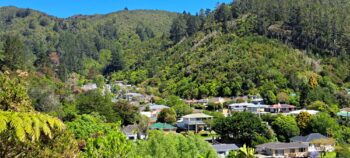 Wainuiomata has a strong sense of community, with many local amenities, schools, parks, and recreational opportunities, such as bushwalks and proximity to nature. The area’s relative distance from the hustle of Wellington (about a 30-minute drive) offers a more laid-back, suburban lifestyle while still being close enough to the city for work and entertainment.
Wainuiomata has a strong sense of community, with many local amenities, schools, parks, and recreational opportunities, such as bushwalks and proximity to nature. The area’s relative distance from the hustle of Wellington (about a 30-minute drive) offers a more laid-back, suburban lifestyle while still being close enough to the city for work and entertainment.
With continuing development and an improving perception of the suburb, Wainuiomata is considered an area with growth potential. As Wellington and Lower Hutt become increasingly expensive, the trend of people moving to Wainuiomata for more affordable housing options is likely to continue. Housing demand is also driving new development, which may mean an increase in both population and amenities over time.

